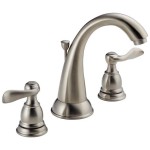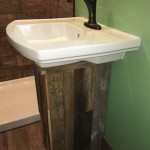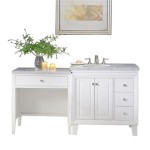Bathroom Vanities For Tight Spaces: Maximizing Functionality and Style
Limited square footage in a bathroom presents a common design challenge. Selecting the appropriate fixtures becomes paramount in creating a functional and aesthetically pleasing space. Bathroom vanities, often the focal point of the room, require careful consideration, especially in compact bathrooms. Choosing the right vanity can significantly impact the overall usability and visual appeal of a small bathroom. This article explores various aspects of selecting bathroom vanities for tight spaces, providing guidance on sizes, styles, storage solutions, and design considerations to optimize limited areas.
Compact Vanity Sizes and Configurations
The cornerstone of selecting a bathroom vanity for a small space lies in understanding size constraints and available configurations. Standard vanity sizes can quickly overwhelm a compact bathroom, making movement difficult and visually shrinking the space. Opting for smaller, more streamlined vanities is essential.
Generally, vanities designed for tight spaces range from 18 inches to 30 inches in width. These smaller dimensions allow for adequate countertop space for essential toiletries without encroaching excessively on the room's footprint. Depth is another critical factor. While standard vanities can be 21 to 24 inches deep, shallower options, between 16 and 18 inches deep, are ideal for maximizing floor space. This reduced depth can create a more comfortable pathway and prevent the vanity from feeling overwhelming.
Wall-mounted vanities, also known as floating vanities, offer a significant advantage in small bathrooms. By attaching the vanity to the wall and leaving the floor space underneath open, the illusion of a larger room is created. This open space allows for easier cleaning and can accommodate small storage baskets or other under-sink organizers. Corner vanities are another excellent option for maximizing space utilization. Designed to fit snugly into a corner, these vanities utilize often-unused areas of the bathroom, freeing up valuable wall space for other fixtures or storage solutions.
When selecting a compact vanity, it is crucial to accurately measure the available space and consider the placement of plumbing connections. Ensuring that the chosen vanity can accommodate the existing plumbing without requiring extensive modifications can save time and money during installation. Additionally, carefully assess the swing of the bathroom door and ensure that the vanity's placement does not impede the door's movement or create an awkward entry point.
Optimizing Storage in Small Vanities
Storage is a critical consideration in any bathroom, and it becomes even more crucial in small bathrooms where space is at a premium. Compact vanities, by their nature, offer limited storage capacity. Therefore, it is essential to select vanities that maximize storage potential through clever design and organizational features.
Vanities with drawers offer a significant advantage over those with only cabinet doors. Drawers provide easier access to stored items and allow for better organization. Shallow drawers are ideal for storing toiletries, makeup, and other small items, while deeper drawers can accommodate larger items such as towels and cleaning supplies. Consider vanities with built-in organizers or dividers within the drawers to further enhance organization and prevent clutter.
Open shelving can also be a useful storage solution in small vanities. Open shelves provide easy access to frequently used items and can also serve as a display area for decorative accents. However, it is important to maintain a tidy and organized appearance to prevent the open shelves from looking cluttered. Using attractive storage baskets or containers can help to contain items and create a more visually appealing display.
Mirror cabinets and medicine cabinets can provide valuable additional storage space above the vanity. These cabinets offer a convenient place to store toiletries, medications, and other personal care items, freeing up space on the vanity countertop. Look for mirror cabinets with adjustable shelves to customize the storage space to suit specific needs. When selecting a medicine cabinet, consider the depth of the cabinet to ensure that it does not protrude excessively into the room and create a safety hazard.
Vertical storage solutions can also be beneficial in small bathrooms. Tall, narrow cabinets or shelving units can utilize vertical space to provide additional storage without taking up valuable floor space. These units can be used to store towels, toiletries, and other bathroom essentials. Consider mounting shelves on the wall above the toilet or in other unused areas of the bathroom to maximize storage potential.
Style and Design Considerations for Tight Bathrooms
While functionality is paramount in small bathrooms, aesthetics should not be overlooked. The style and design of the vanity can significantly impact the overall look and feel of the room. Selecting a vanity that complements the existing décor and enhances the sense of space is essential.
Light colors and finishes can help to create the illusion of a larger room. Opting for a vanity in a light shade, such as white, beige, or light gray, can reflect light and make the bathroom feel brighter and more spacious. Avoid dark colors and heavy finishes, as these can absorb light and make the room feel smaller and cramped.
Mirrors play a crucial role in enhancing the sense of space in small bathrooms. A large mirror above the vanity can reflect light and create the illusion of depth. Consider a mirror that extends the entire width of the vanity to maximize its impact. Alternatively, a mirror cabinet can provide both storage and reflective surface, combining functionality and aesthetics.
Streamlined and minimalist designs are ideal for small bathrooms. Avoid vanities with ornate details or bulky features, as these can overwhelm the space. Opt for clean lines, simple shapes, and understated hardware. A minimalist vanity can create a sense of calm and order, making the bathroom feel more spacious and inviting.
The choice of countertop material can also impact the overall look and feel of the bathroom. Quartz and granite are popular choices for their durability and aesthetic appeal. However, these materials can be expensive. Laminate countertops offer a more affordable alternative and are available in a wide range of colors and patterns. Consider the overall color scheme and design of the bathroom when selecting a countertop material.
Proper lighting is essential in any bathroom, and it is especially important in small bathrooms where natural light may be limited. Ensure that the vanity area is well-lit with a combination of ambient, task, and accent lighting. Install overhead lighting to provide general illumination, and add task lighting above the mirror to provide focused light for grooming and makeup application. Accent lighting can be used to highlight decorative features or create a more relaxing atmosphere.
Finally, consider the overall flow and layout of the bathroom when selecting a vanity. Ensure that the vanity's placement allows for easy movement around the room and does not obstruct access to other fixtures. Carefully consider the placement of the toilet, shower, and other bathroom elements to create a cohesive and functional space. A well-planned layout can maximize the usability of a small bathroom and create a more comfortable and enjoyable environment.

15 Small Bathroom Vanity Ideas That Rock Style And Storage

10 Small Powder Room Vanity Ideas You And Your Guests Will Both Love

Bathroom Vanity Ideas The Home Depot

15 Small Bathroom Vanity Ideas That Rock Style And Storage

Diy Bathroom Vanity 12 Rehabs Bob Vila

16 Small Bathroom Vanities 24 Inches Under Kelley Nan

10 Small Powder Room Vanity Ideas You And Your Guests Will Both Love

Small Bathroom Vanities

The Best 19 Small Bathroom Vanities Of 2024

Bathroom Vanity Styles To Fit Your Space Forbes Home
Related Posts







